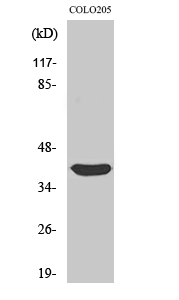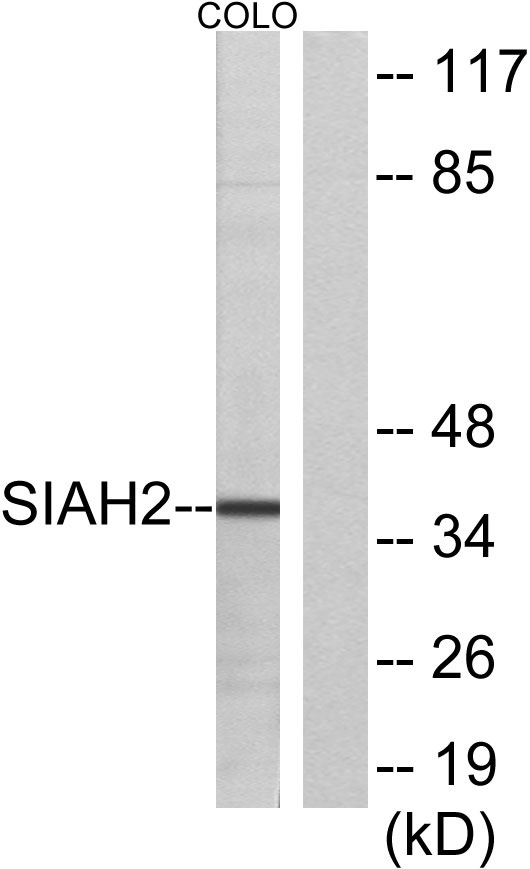Siah-2 Polyclonal Antibody
- Catalog No.:YT4297
- Applications:WB;IHC;IF;ELISA
- Reactivity:Human;Mouse;Rat
- Target:
- Siah-2
- Gene Name:
- SIAH2
- Protein Name:
- E3 ubiquitin-protein ligase SIAH2
- Human Gene Id:
- 6478
- Human Swiss Prot No:
- O43255
- Mouse Gene Id:
- 20439
- Mouse Swiss Prot No:
- Q06986
- Rat Gene Id:
- 140593
- Rat Swiss Prot No:
- Q8R4T2
- Immunogen:
- The antiserum was produced against synthesized peptide derived from human SIAH2. AA range:241-290
- Specificity:
- Siah-2 Polyclonal Antibody detects endogenous levels of Siah-2 protein.
- Formulation:
- Liquid in PBS containing 50% glycerol, 0.5% BSA and 0.02% sodium azide.
- Source:
- Polyclonal, Rabbit,IgG
- Dilution:
- WB 1:500 - 1:2000. IHC 1:100 - 1:300. ELISA: 1:20000.. IF 1:50-200
- Purification:
- The antibody was affinity-purified from rabbit antiserum by affinity-chromatography using epitope-specific immunogen.
- Concentration:
- 1 mg/ml
- Storage Stability:
- -15°C to -25°C/1 year(Do not lower than -25°C)
- Other Name:
- SIAH2;E3 ubiquitin-protein ligase SIAH2;Seven in absentia homolog 2;Siah-2;hSiah2
- Observed Band(KD):
- 38kD
- Background:
- This gene encodes a protein that is a member of the seven in absentia homolog (SIAH) family. The protein is an E3 ligase and is involved in ubiquitination and proteasome-mediated degradation of specific proteins. The activity of this ubiquitin ligase has been implicated in regulating cellular response to hypoxia. [provided by RefSeq, Jul 2008],
- Function:
- domain:The RING-type zinc finger domain is essential for ubiquitin ligase activity.,domain:The SBD domain (substrate-binding domain) mediates the homodimerization and the interaction with substrate proteins. It is related to the TRAF family.,function:E3 ubiquitin-protein ligase that mediates ubiquitination and subsequent proteasomal degradation of target proteins. E3 ubiquitin ligases accept ubiquitin from an E2 ubiquitin-conjugating enzyme in the form of a thioester and then directly transfers the ubiquitin to targeted substrates. Mediates E3 ubiquitin ligase activity either through direct binding to substrates or by functioning as the essential RING domain subunit of larger E3 complexes. Triggers the ubiquitin-mediated degradation of many substrates, including proteins involved in transcription regulation (POU2AF1, PML, NCOR1), a cell surface receptor (DCC), an antiapoptotic protein (B
- Subcellular Location:
- Cytoplasm . Nucleus . Predominantly cytoplasmic. Partially nuclear. .
- Expression:
- Widely expressed at low level.
HMGB1-induced activation of ER stress contributes to pulmonary artery hypertension in vitro and in vivo. Manxiang Li WB Rat lung tissue
- June 19-2018
- WESTERN IMMUNOBLOTTING PROTOCOL
- June 19-2018
- IMMUNOHISTOCHEMISTRY-PARAFFIN PROTOCOL
- June 19-2018
- IMMUNOFLUORESCENCE PROTOCOL
- September 08-2020
- FLOW-CYTOMEYRT-PROTOCOL
- May 20-2022
- Cell-Based ELISA│解您多样本WB检测之困扰
- July 13-2018
- CELL-BASED-ELISA-PROTOCOL-FOR-ACETYL-PROTEIN
- July 13-2018
- CELL-BASED-ELISA-PROTOCOL-FOR-PHOSPHO-PROTEIN
- July 13-2018
- Antibody-FAQs
- Products Images

- Western Blot analysis of various cells using Siah-2 Polyclonal Antibody

- Western blot analysis of lysates from COLO cells, using SIAH2 Antibody. The lane on the right is blocked with the synthesized peptide.

- Immunohistochemical analysis of paraffin-embedded human tonsil. 1, Antibody was diluted at 1:200(4° overnight). 2, Tris-EDTA,pH9.0 was used for antigen retrieval. 3,Secondary antibody was diluted at 1:200(room temperature, 45min).



